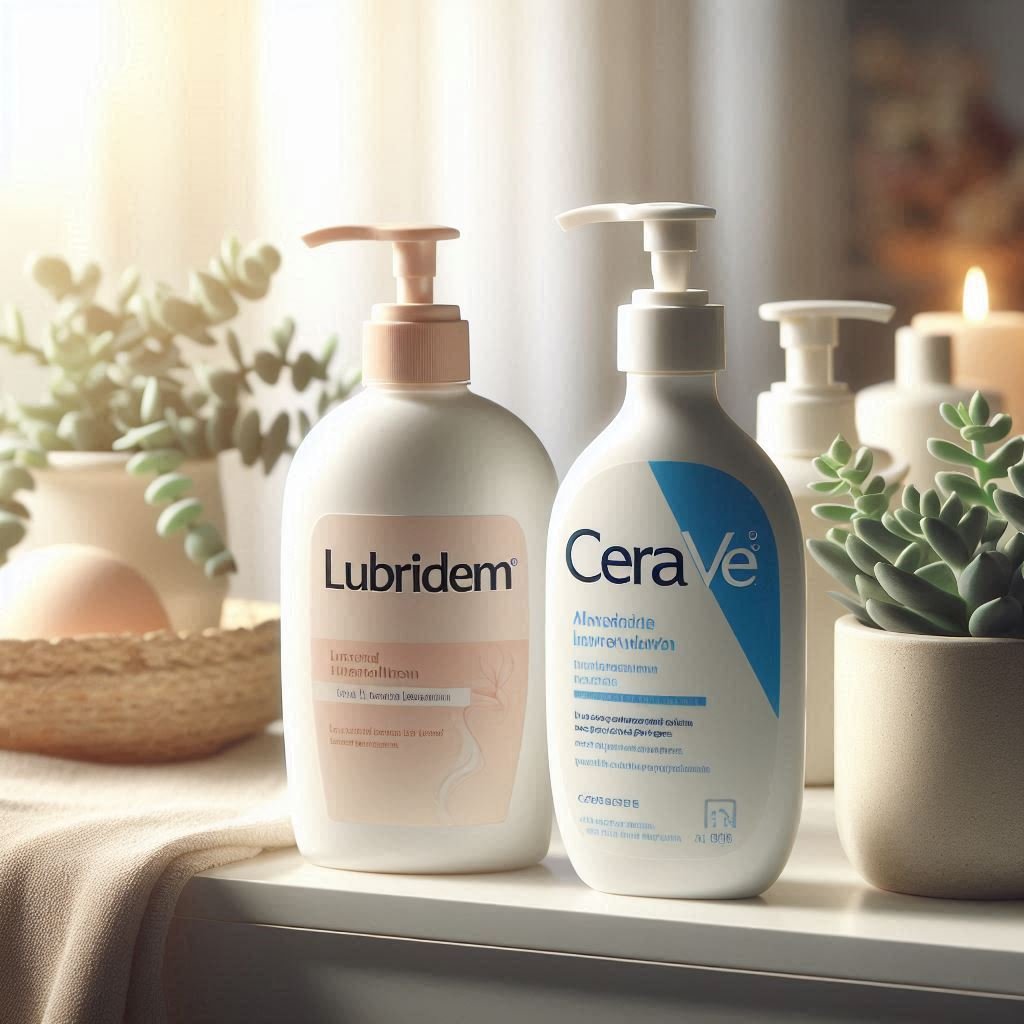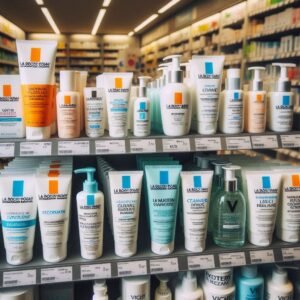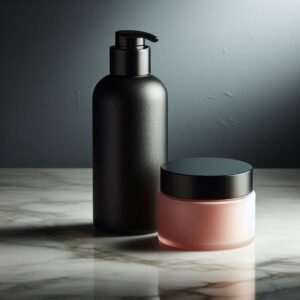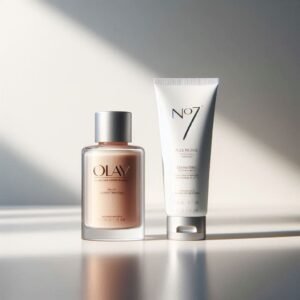You’re on a mission to find the perfect moisturizer, and you’ve narrowed it down to two popular brands: Lubriderm and CeraVe. Both seem to promise the same benefits, but you sense there’s more to the story.
As you stand in front of the skincare aisle, you wonder: what’s the real difference between these two brands? Do their unique approaches to skincare make one more suitable for your skin type than the other? You’re about to uncover the answers.
A Quick Overview
- Lubriderm focuses on locking in moisture, while Cerave emphasizes repairing the skin’s natural barrier, making them suitable for different skin concerns.
- Cerave’s products are fragrance-free and gentle, whereas Lubriderm offers a broader spectrum of fragrances, catering to diverse preferences.
- Lubriderm’s formulas often feature hyaluronic acid, glycerin, and dimethicone for long-lasting hydration, whereas Cerave relies on its patented Multimolecular Oiling Technology.
- Lubriderm’s products tend to be thicker and more luxurious, while Cerave’s products are lightweight and non-greasy, affecting absorption and texture.
- When comparing prices, Lubriderm tends to be more budget-friendly, with a lower cost per ounce, making it a more affordable option for some consumers.
Brand Histories and Backgrounds
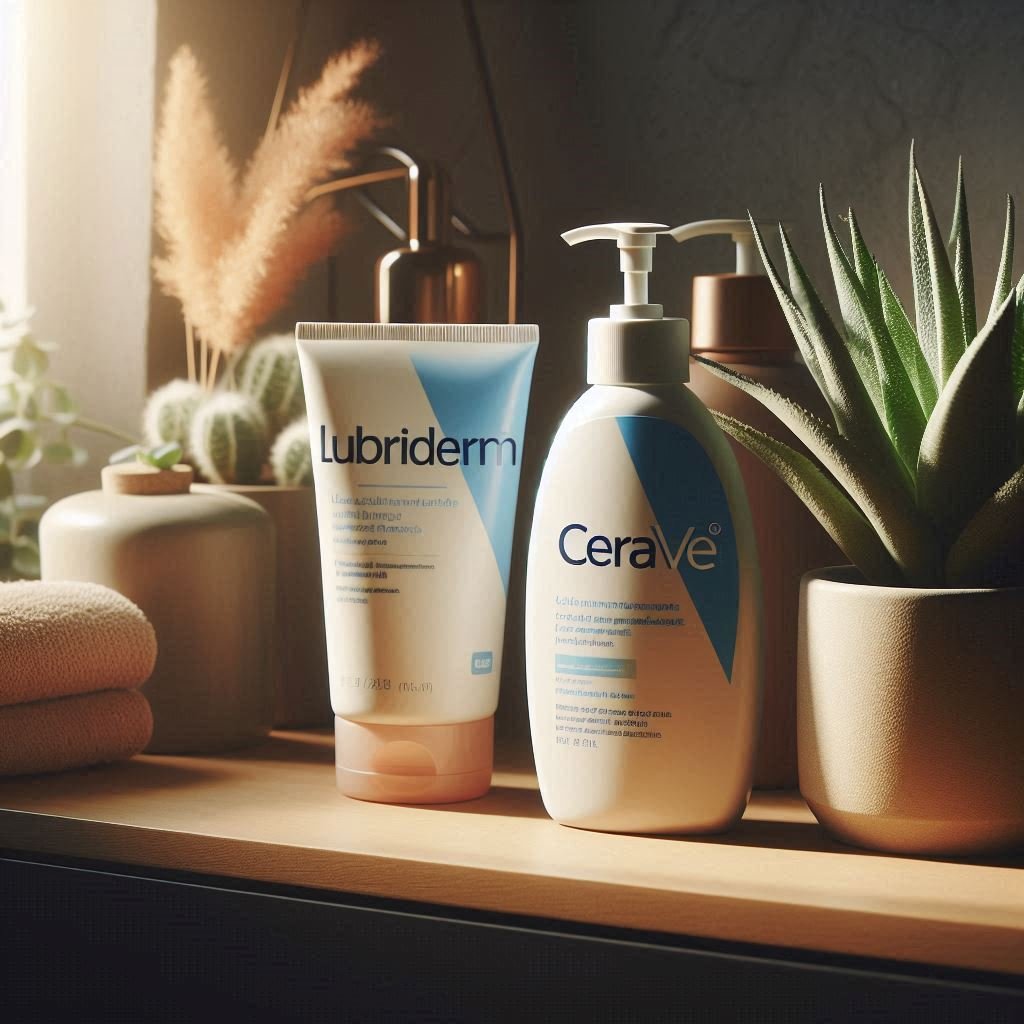
When exploring the world of moisturizers, understanding the brand histories and backgrounds of Lubriderm and Cerave can provide valuable insight into their development and formulation philosophies.
Lubriderm, founded in 1958, has undergone substantial brand evolution, with multiple acquisitions and mergers shaping its current identity.
Initially, the company focused on creating moisturizers for dry skin, but it has since expanded its product line to cater to various skin types.
Cerave, on the other hand, was founded in 2005 by a team of dermatologists who sought to create products that would repair and restore the skin’s natural barrier.
Their company founders’ expertise in dermatology has profoundly influenced the brand’s formulation philosophy, prioritizing gentle, non-irritating ingredients that work in harmony with the skin.
Key Ingredients and Formulations
As you examine the labels of Lubriderm and Cerave products, you’ll notice distinct formulations that set them apart.
You’ll find that Cerave’s proprietary Multimolecular Oiling Technology and Essential Ceramides work in tandem to repair and lock in moisture.
Meanwhile, Lubriderm’s formulas often feature a blend of moisturizing powerhouses like hyaluronic acid, glycerin, and dimethicone to provide long-lasting hydration.
Moisturizing Powerhouses Compared
You’re likely familiar with the rich, non-greasy textures of both Lubriderm and CeraVe, but what sets them apart is their distinct key ingredients and formulations.
As you navigate the world of skincare trends, crucial to understand is to debunk moisturizer myths and focus on the facts.
Both brands have developed unique blends to address specific skin concerns.
Lubriderm’s formulas often feature a combination of moisturizing agents, such as glycerin and petrolatum, to provide long-lasting hydration.
CeraVe, on the other hand, relies on its patented Multimolecular Oligopeptide technology to repair and strengthen the skin’s barrier function.
Ingredient Breakdown Analysis
Your skin type and concerns dictate which moisturizer will work best for you, so let’s dissect the key ingredients and formulations that set Lubriderm and CeraVe apart.
Lubriderm’s formula customization caters to specific skin concerns, such as dryness or sensitivity, with targeted ingredients like hyaluronic acid and glycerin.
CeraVe, on the other hand, focuses on chemical synergy, combining ceramides, hyaluronic acid, and essential fatty acids to repair and lock in moisture.
While Lubriderm’s ingredients may vary depending on the specific product, CeraVe’s consistent formula across its range guarantees a reliable, gentle, and effective moisturizing experience.
Moisturizing Product Lines Compared
Comparing Lubriderm and CeraVe’s moisturizing product lines reveals distinct approaches to hydrating the skin, with each brand offering a range of formulas tailored to specific skin types and needs.
As you navigate these options, identifying the critical factors is vital. Debunking common moisturizing myths, such as the idea that all moisturizers are created equal, will help you make informed decisions about your skincare routine.
When choosing between Lubriderm and CeraVe, consider the following key differences:
Product preferences: Lubriderm is known for its lightweight, non-greasy formulas, while CeraVe offers thicker, more emollient options.
Moisturizing strategies: Lubriderm focuses on locking in moisture, while CeraVe emphasizes repairing the skin’s natural barrier.
Customization: Both brands offer a range of products catering to different skin types and concerns, allowing you to find the perfect fit for your unique needs.
Skin Type Suitability Analysis
As you consider the Lubriderm and Cerave product lines, you’ll want to examine how each brand addresses your specific skin type needs.
If you have normal skin, you’re looking for a moisturizer that won’t clog pores or exacerbate oiliness.
But if you have dry or sensitive skin, you’ll need to pay close attention to the ingredients and formulations that can either soothe or irritate your skin.
Normal Skin Needs
Normal skin, characterized by a balanced moisture barrier and minimal sensitivity, requires gentle, non-irritating products that maintain its natural equilibrium.
As someone with normal skin, your skin goals likely revolve around maintaining this balance and enhancing your natural glow. In your daily routines, you’re looking for products that support your skin’s natural functions without disrupting its delicate balance.
Key considerations for normal skin:
Moisturizing: You need a moisturizer that provides adequate hydration without clogging pores or feeling greasy.
Sun protection: A broad-spectrum sunscreen with a lightweight, non-greasy texture is essential for daily use.
Gentle cleansing: A mild, fragrance-free cleanser that effectively removes dirt and impurities without stripping your skin of its natural oils is a must.
Dry Skin Concerns
You face a unique set of challenges if you have dry skin, which is characterized by a weakened moisture barrier and increased sensitivity, requiring specialized care to alleviate discomfort and restore hydration.
During winter, dry skin can become even more problematic, making winter skincare a vital aspect of your routine.
To address these concerns, you need a moisturizer that not only locks in moisture but also supports skin renewal.
Look for ingredients that promote cell turnover, such as hyaluronic acid, glycerin, and ceramides, which help to strengthen your skin’s natural barrier.
Sensitive Skin Issues
When choosing a moisturizer, your skin’s sensitivity level plays a significant role in determining the product’s tolerability and effectiveness. If you have sensitive skin, you’re more prone to skin irritations and allergies. You need a moisturizer that’s gentle, non-irritating, and hypoallergenic.
Fragrance-free formulas are essential, as products with artificial fragrances can trigger allergic reactions and skin irritation.
Soothing ingredients like aloe vera, chamomile, or green tea can help reduce inflammation and redness in moisturizers.
The product’s pH level is also crucial, and it should be close to your skin’s natural pH to prevent irritation and discomfort.
Fragrance and Scent Options
Both Lubriderm and CeraVe offer a range of fragrance and scent options to cater to individual preferences, with Lubriderm featuring a broader spectrum of fragrances.
When it comes to scent preferences, you may find that Lubriderm’s extensive options better suit your taste. From classic and subtle to fruity and floral, Lubriderm’s fragrance options are designed to appeal to a wide range of consumers.
On the other hand, CeraVe takes a more minimalist approach, focusing on fragrance-free and gentle scents that won’t irritate sensitive skin.
If you’re particular about fragrance, you’ll appreciate the variety Lubriderm offers. However, if you prioritize gentle, non-irritating scents, CeraVe may be the better choice for you.
Product Texture and Absorption
With regard to product texture and absorption, Lubriderm and CeraVe exhibit distinct differences that may influence your purchasing decision.
As you explore these products, you’ll notice that Lubriderm offers a rich, luxurious feel, while CeraVe provides a lightweight, non-greasy texture.
Lubriderm’s moisturizers often have a thicker, creamier consistency, providing an indulgent experience for your skin.
CeraVe’s products, on the other hand, are designed to absorb quickly, leaving no residue behind.
Lubriderm’s thicker formula may be better suited for dry or sensitive skin, while CeraVe’s lightweight approach is ideal for oily or combination skin.
Price Points and Value Analysis
When evaluating the price points of Lubriderm and Cerave, you’ll want to ponder the cost per ounce breakdown to get a clear understanding of which brand offers the best value.
By comparing the prices of each brand, you’ll be able to make an informed decision about which one fits your budget.
As you weigh your options, you’ll also want to explore budget-friendly alternatives that can provide similar benefits without breaking the bank.
Cost Per Ounce Breakdown
You’ll want to examine the cost per ounce breakdown of Lubriderm and CeraVe to determine which moisturizer offers the best value for your money. When comparing the two, you’ll notice distinct price dynamics.
The 16-ounce bottle of Lubriderm costs around $13, working out to $0.81 per ounce.
The 12-ounce bottle of CeraVe costs around $13, making it $1.08 per ounce.
If you’re looking for a more budget-friendly option, consider buying in bulk or opting for a larger bottle size to reduce the cost per ounce.
Brand Comparison Pricing
Now that you’ve examined the cost per ounce breakdown, let’s analyze the brand comparison pricing to determine which moisturizer offers the best value for your money.
When considering brand loyalty, key to keep in mind is to assess the overall pricing strategy of each brand.
Lubriderm tends to be priced lower than CeraVe, which may appeal to those on a tighter budget.
However, CeraVe’s premium packaging and reputation may justify the higher price point for some consumers.
The packaging impact is also vital, as CeraVe’s eco-friendly approach may sway environmentally conscious customers.
Ultimately, the best value for your money depends on your individual priorities and preferences.
Budget-Friendly Options
If budget is a top concern, Lubriderm’s lower price points across its product range may offer the most affordable options for you.
When faced with budget constraints, you don’t have to make drastic beauty compromises.
Moisturizers under $10: Lubriderm’s daily moisturizers are priced between $5-$10, making them an accessible option for those on a tight budget.
Body lotions under $15: Their body lotions are priced between $10-$15, offering an affordable solution for dry skin.
Travel-sized options: Lubriderm’s travel-sized products are perfect for trying out new products without breaking the bank.
User Reviews and Ratings Compared
By examining user reviews and ratings, it becomes clear that both Lubriderm and CeraVe have garnered significant attention and loyalty from customers, with each brand boasting its own strengths and weaknesses concerning user satisfaction.
When you scour review platforms like Amazon, Walmart, and Ulta, you’ll notice rating inconsistencies between the two brands.
Lubriderm tends to excel in respect of price and moisturizing capabilities, with many users praising its affordability and hydrating properties.
CeraVe, on the other hand, is often commended for its gentle, non-comedogenic formula and its ability to soothe sensitive skin.
However, some users have reported inconsistent results with CeraVe’s moisturizing capabilities.
Dermatologist and Expert Endorsements
As you consider the credibility of Lubriderm and CeraVe, crucial to examine is to look at dermatologist and expert endorsements. Dermatologists and skincare experts widely recommend CeraVe, citing its formulation and ingredients that meet the highest standards of skin health, while Lubriderm also receives endorsements from experts, albeit to a lesser extent.
CeraVe has received numerous awards from reputable organizations, such as the National Eczema Association and the Skin Cancer Foundation, for its commitment to skin health.
CeraVe has been endorsed by celebrities like Emma Roberts and Rachel Brosnahan, who swear by its products for their sensitive skin.
CeraVe has partnered with dermatologists and skincare experts to develop products that address specific skin concerns, further solidifying its reputation as a trusted brand.
Common Skin Concerns Addressed
When it comes to addressing common skin concerns, you’re likely looking for products that can effectively tackle issues like dryness, acne, and sensitivity.
Both Lubriderm and Cerave are designed to combat these concerns, but in different ways.
Skin expert opinions agree that Cerave’s ceramide-based formula helps repair the skin’s natural barrier, reducing dryness and irritation.
Lubriderm, on the other hand, uses a moisturizing complex to lock in hydration.
When it comes to acne, Cerave’s non-comedogenic formula won’t clog pores, while Lubriderm’s gentle, fragrance-free option is suitable for sensitive skin.
Skin myth busting reveals that not all moisturizers are created equal, and choosing the right one can make all the difference.
Final Verdict and Recommendations
Considering your unique skin concerns and the distinct benefits of each product, you can now make an informed decision between Lubriderm and Cerave based on their respective strengths in addressing dryness, acne, and sensitivity.
If you’re looking for a lightweight moisturizer for daily use, Cerave might be the better fit.
Lubriderm’s intense hydration can help you achieve softer, more radiant skin, giving you skin confidence.
If you struggle with acne-prone skin, Cerave’s non-comedogenic formula might be a better option.
Frequently Asked Questions
Can I Use Lubriderm and Cerave Products on My Baby’s Skin?
You’re wise to ponder your baby’s skin type when choosing moisturizers; for newborns to toddlers, gentle, fragrance-free products meet infant moisturizing needs, so yes, you can use Lubriderm and Cerave products on your baby’s sensitive skin.
Are Lubriderm and Cerave Products Cruelty-Free and Vegan-Friendly?
You’re likely wondering if Lubriderm and Cerave products align with your values. Rest assured, both brands have committed to ending animal testing, earning them spots as ethical brands, but only Cerave offers vegan-friendly options, giving you peace of mind.
Can I Use Lubriderm and Cerave Products on Open Wounds or Cuts?
You shouldn’t use Lubriderm or Cerave products on open wounds or cuts, as they’re not formulated for wound care concerns. Instead, prioritize the wound healing process with gentle, fragrance-free cleansers and topical antibiotics, as advised by a healthcare professional.
Do Lubriderm and Cerave Products Contain SPF for Sun Protection?
You prioritize daily protection, so you’re wondering if Lubriderm and Cerave products contain SPF for sun protection. The answer is, some do, emphasizing the importance of sunscreen in your daily routine to prevent skin damage.
Are Lubriderm and Cerave Products Available in Travel or Sample Sizes?
You’ll be relieved to know that yes, both brands offer travel-friendly options, allowing you to take your skincare on-the-go with travel kits and miniature options, perfect for fitting into your busy lifestyle.
Conclusion
Based on your skin type and concerns, you now have a thorough understanding of Lubriderm and CeraVe‘s approaches to skincare.
Lubriderm’s lightweight, fragrance-rich options may suit those seeking a non-greasy feel, while CeraVe’s thicker, repair-focused formulas may benefit those with compromised skin barriers.
Consider your individual needs and prioritize accordingly.
If you’re still unsure, consult with a dermatologist or skincare expert to determine the best moisturizer for your unique skin profile.

